
Grey Gemstones: List of 15 Grey Gems
 Not every gemstone is black and white—there’s a lot of grey, and by grey, we mean grey and silver gemstones!
Not every gemstone is black and white—there’s a lot of grey, and by grey, we mean grey and silver gemstones!
We don’t usually think of gemstones when we see the color grey. We might think of cloudy days and ashes, of gloomy storms, a lack of color, or gasp grey hairs popping up as we age.
Grey’s not all bad, though! We know that from George Clooney’s lovely salt-and-pepper look and Meryl Streep’s grey textured bobs and up-dos. Those two stars certainly make grey look cool and elegant, but here’s the truth: grey was already elegant, as we can see from the grey stones and crystals that have been around for thousands of years!
So, what crystal is grey? What gems are silver? Today we’ll cover all the grey crystal names, including light grey crystals, dark grey crystals, and silver gemstones, like:
Grey Gemstone Names
Hematite
Hawk’s Eye Stone
Alexandrite Spinel
Druzy
Grey Sapphire
Botswana Agate
Tahitian Pearl
Grey Fluorite
Grey Moonstone
Snowflake Obsidian
Labradorite
Onyx
Iolite
Grey Calcite
Chrysocolla
What is a gray stone called, and what is the grey crystals meaning? As you can see, grey stones have many names, and we’ll go through how they differ in appearance, feel, and healing properties.
First, let’s cover the grey gemstone meaning. Like Meryl Streep and George Clooney’s classy-cool vibe, grey gemstones are sophisticated, balanced, calm, and simple. The color displays elegance in its simplicity, and its neutrality channels balance and groundedness. After all, it is the balance between black and white.
What healing stone is grey? All grey stones are healing in their own way. Let’s jump into our long list of grey crystals names.
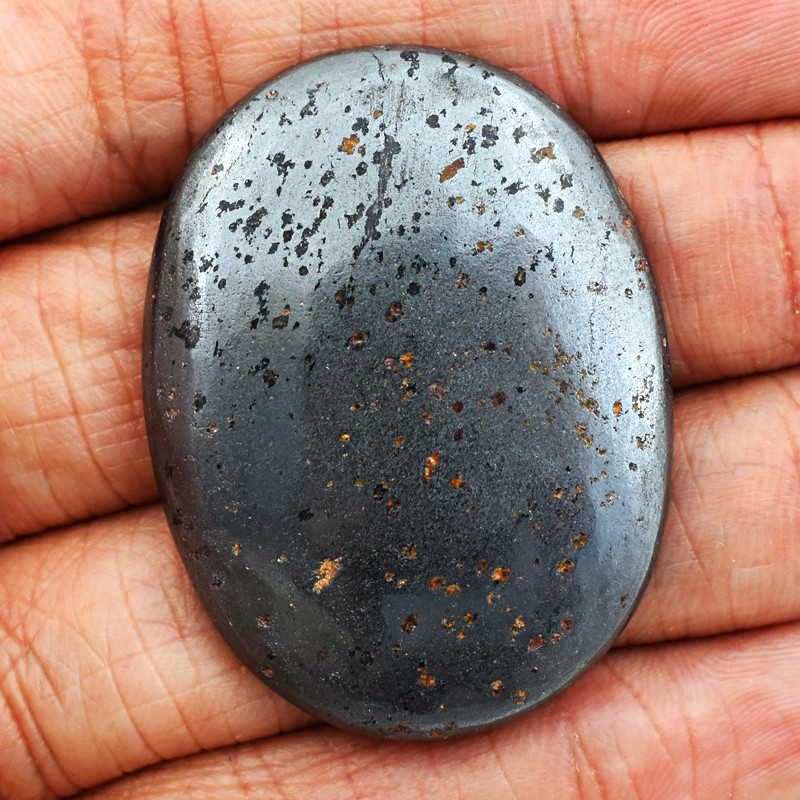
Hematite
Hematite is a predominantly silver-grey, semi-precious gemstone. Its name might remind you of blood, but you might not know why. You’re probably thinking of hemoglobin, the protein that gives red blood cells their color. Both hematite and hemoglobin come from the Greek word haima, which means blood.
Why does a grey stone’s name have an origin of red blood? Although grey in color, hematite boasts sharp crimson lines when scratched, and ancient people used that red crimson streak as one of their first writing devices! Resembling red chalk, hematite was used as an ancient pen in South Africa thousands of years ago.
Nicknamed the Stone of Mental Mastery, hematite has grounding properties that support concentration, emotional healing, and focus. Naturally, it connects with our root chakras, connecting us to Earth. Made of 70% iron, hematite is also known for helping the body absorb iron and aiding those with anemia.
On the Mohs scale for mineral hardness, hematite scores 5 to 6.5, making its durability more comparable to glass than chalk. With such secure and grounding energy, it's no wonder hematite is the Capricorn’s zodiac stone!
Let’s take a look at another stone with South African origins!
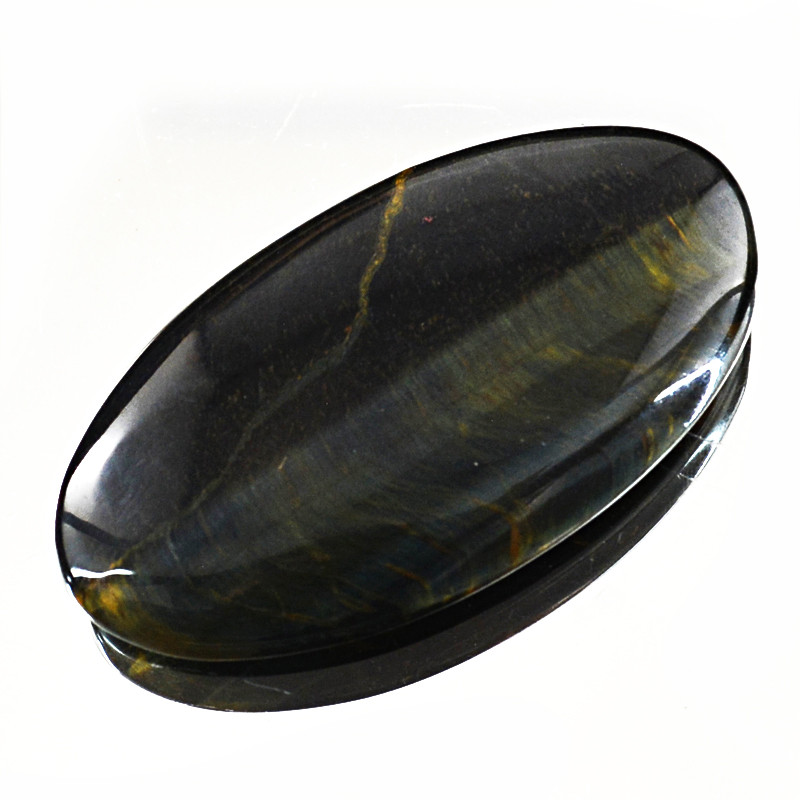
Hawk’s Eye
You might have heard of tiger’s eye, but allow us to introduce his greyish-blue little brother, hawk’s eye. A pseudomorph of macrocrystalline quartz, the hawk's eye appears primarily in South Africa and Thailand; however, you can also find it in Spain, Burma, and Australia.
Hawk’s eye has a silky reflective surface displaying crumpled inner lines, also known as inclusions, that can create a long stripe of light along the stone’s surface. This reflective feature is called chatoyancy, or “cat’s eye effect,” and it helped the stone get its name!
Hawk’s eye helps us connect to our third eye chakra, which supports intuition and consciousness. Like hematite, hawk's eye enhances our connection with the world. Other healing properties include:
Reducing inflammation
Soothing headaches
Calming anxiety and panic attacks
People like to use the hawk’s eye gemstone as an evil eye to ward off negative energies like jealousy and curses. And if you’re a Saggitarius, you get to call the lovely hawk’s eye your zodiac stone!
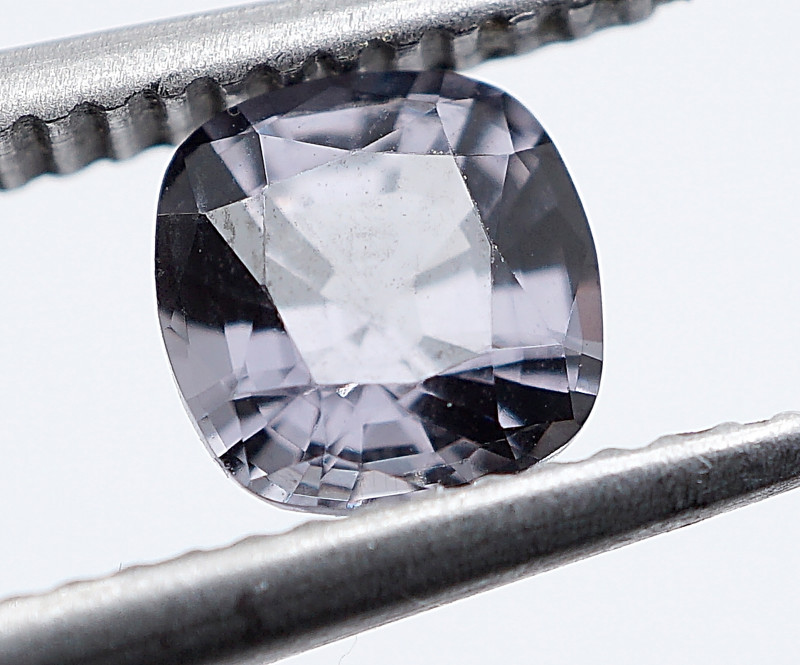
Alexandrite Spinel
Alexandrite spinel is the greyish-blue variety of the more commonly ruby-hued spinel gem.
Many spinel stones are colorless, and alexandrite spinel gets its greyish coloring from exposure to elements like iron, chromium, and cobalt. The greyish hue shows in the daytime, but alexandrite spinel parties at night by peacocking a gorgeous, amethyst-like violet hue! This is where it gets its name, referencing the color-changing chrysoberyl variety alexandrite.
Spinel comes from the Latin word spina, which means “thorn.” Spinel crystals look spiky, and the shape is thought to have influenced the name. Spinel carries protective energies, making it an excellent healing stone for balancing emotions, healing trauma, and blocking negative influences.
What makes spinels channel such strong protective energy? Perhaps the stone’s strength and durability, as it sports a 7.5 to 8 ranking on the Mohs hardness scale!
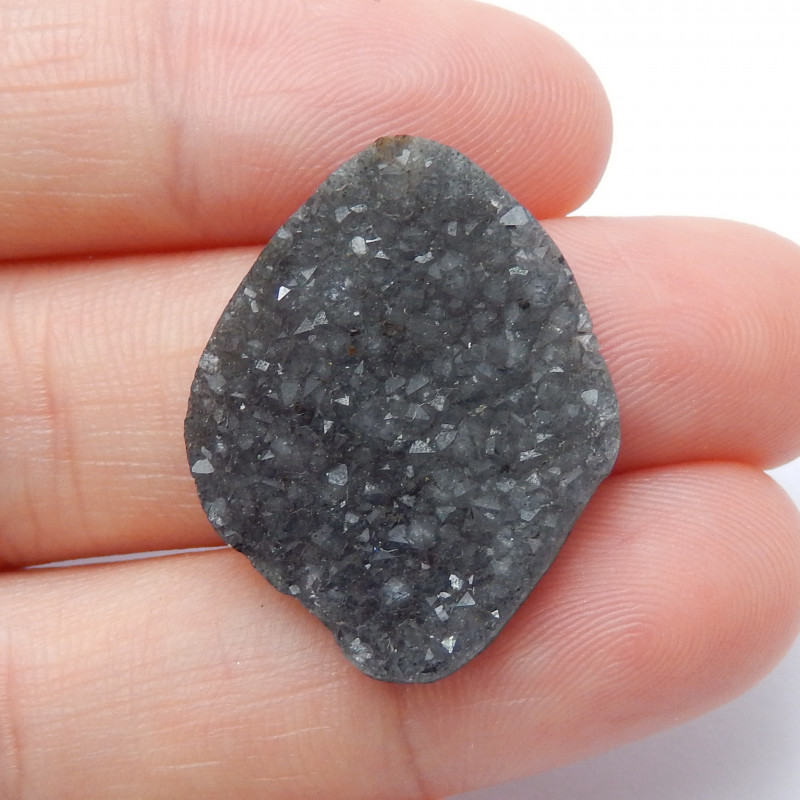
Druzy
Druzy is a type of grey quartz, a sparkling little crystal found inside quartz geodes. In fact, these stones are nestled deep within solid, round rocks and make up only 5% of the crystals forming inside the quartz geodes. Druzy stones rank at 6 on the Mohs scale and are commonly found in Thailand, Brazil, India, and China.
Druzy gets its sparkly finish from a titanium coat. But, this stone isn’t just about beauty. What is grey quartz used for?
Crystal healers love druzy’s cleansing healing properties for the circulatory and reproductive systems. Emotionally, druzy helps you find mental clarity and stability to overcome fear. Nicknamed the “Gemstone of Heaven,” this grey crystal quartz is associated with optimism, wisdom, and harmony.
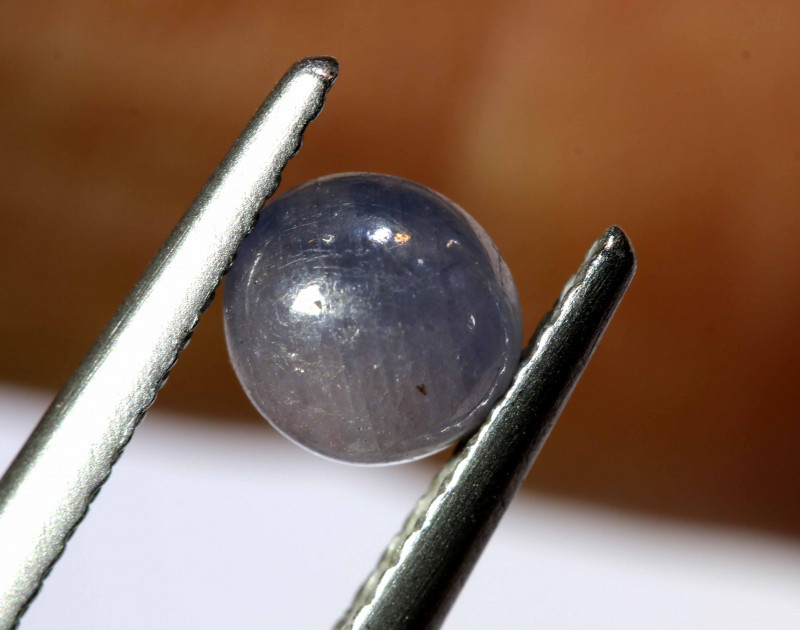
Grey Sapphire
Did your birthday just pass in September? Lucky you, since the grey sapphire is the September birthstone! One of the four precious gemstones, sapphire comes from the Latin word saphirus and the Greek word Sapheiros, both symbolizing the color blue.
You might recognize a famous blue sapphire from tabloid pictures, appearing in the late Princess Diana’s ring. When you think about what crystal is grey, sapphire might not be the first stone you think of. However, sapphire comes in so many different colors, including grey.
You can also find greyish-blue sapphires, though they’re less valuable than the intensely blue varieties. Many brides sport grey sapphires these days instead of traditional diamonds, because they’re just as gorgeous with a much lighter price tag.
Now for the healing properties. Sapphires pack a spiritual punch, as they help people find clarity and serenity during times of spiritual confusion. They also symbolize joy and lightness, restoring balance and connecting your spirit to your mental and physical sides.

Botswana Agate
Botswana is home to the Okavango Delta, a massive landform with water covering grasslands, offering a space of immense wildlife and fertility. This delta is one of Africa’s 7 Natural wonders. But Botswana has another world wonder — Botswana Agate!
This agate variety and chalcedony first appeared over 187 million years ago in African volcanoes. Lava slowly flowed down rocks over millions of years to create silica, under which Botswana agate veins formed in cool color bands and patterns. These color bands make Botswana agate a rare gemstone and worth a pretty penny!
Most Botswana agate is grey, white, or brown with blue, pink, or green stripes. Nicknamed the “Sunset Stone,” this gemstone has a calming color and soothing properties.
Historically, women would use this stone to promote health in pregnancy during fertility ceremonies, and it was thought to lead to a strong child at birth! No wonder, considering the stone has a 7 ranking on the Mohs hardness scale!
Other healing properties include:
Stabilizing and grounding energy
Increased emotional maturity
Removing negative energy
Because of this agate’s grounding properties, it connects strongly with your root chakra, helping you feel safe and strong.
Next up, what gems are silver? You might be surprised to hear: Tahitian pearls!

Tahitian Pearl
Silver is the new white when it comes to pearls. Meet the Tahitian Pearl — the second-most expensive pearl variety with colors ranging across the black-to-white scale.
More commonly known as black pearls, Tahitian pearls are known to show shades of grey and silver. Since they range so much in color, it’s quite difficult to create a necklace with uniform Tahitian pearls. Plus, these gems are very rare.
Why are they so rare? This pearl only grows in French Polynesia, and the government there strictly regulates its production.
Any pearl darker than white or clear comes from a black-lipped oyster called the Pinctada margaritifera. A delicate stone, these pearls only rank between 2.5 to 4.5 on the Mohs scale.
Pearls symbolize mother nature, representing femininity and the moon. Vedic mythology posits that the world’s water and divine providence gave birth to pearls with a lightning bolt! The Bible says they grew from Eve’s tears after she was banished from the Garden of Eden.
With all this divine energy, it’s no surprise that pearls symbolize wisdom, knowledge, and intelligence. Which zodiac do you think this wise stone connects with? The conversing, intellectual Gemini, of course! The pearl is also the June birthstone.
With Mother Nature’s fertile glow, pearls are known to balance hormones and heal women in their birthing time. They connect with the heart chakra, which helps you connect with your intuition and heal deep emotional pain.

Grey Fluorite
Fluorite is a rainbow in a gemstone with its gorgeous fluorescence and abundance of colors. If you’re a Capricorn or Pisces, you have the honor of calling fluorite your zodiac stone. But when thinking of grey and white crystal names, rainbows don’t usually come to mind. Lo and behold, fluorite comes in shades of grey!
With a 4 Mohs rating, fluorite is a fragile stone made up of calcium and fluorine. Although it’s delicate, fluorite has dazzled people since ancient times, when people associated the stone with wisdom and enlightenment. Ancient Greeks tied fluorite to purity and sobriety.
Strongly connected to the crown and heart chakras, and all other chakras in some respect, fluorite is abundant with healing properties.
Fluorite is known as the “Genius Stone,” known to assist with mental confusion, disillusionment, or lack of direction. Physically, some use it for improving tooth strength and throat health.
Does grey show up in the rainbows of other stones? Read on to find out!
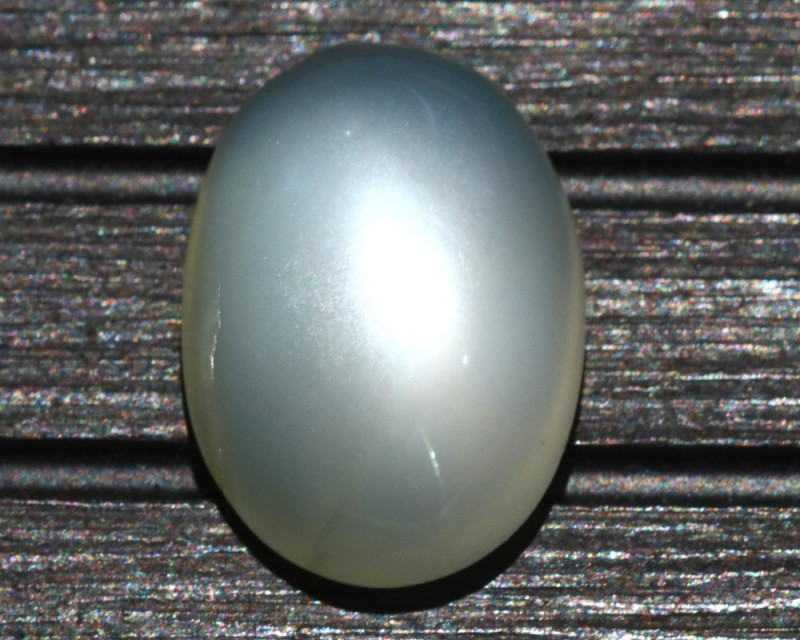
Grey Moonstone
Moonstones channel peace and love with every gorgeous color variation, including the grey moonstone! These celestial stones are orthoclase feldspar stones with a shine comparable to the moon’s striking glow.
How did people see moonstones in history? Were they awarded the same awe we give them today? Apparently yes! In Ancient India, moonstones symbolized everlasting love and represented the lunar God Chandra, who wore a stone in his forehead that glowed with the moon’s movements.
Does that image sound familiar? Then you won’t be surprised to hear that moonstone connects to our third eye chakra. With this connection to the third eye, moonstones offer many healing properties, such as:
Releasing negativity
Addressing grief
Improving sexual energy
Enhancing your connection to self
Feeling romantic? So are moonstones, as they’re birthstones of the bridal month of June!

Snowflake Obsidian
You might know the mysterious black stone we call obsidian. Made of volcanic glass, this versatile stone is found in both furniture and jewelry. Snowflake obsidian is a variety that shows small whitish-grey speckled inclusions along the black stone, similar to a winter day’s snowflakes!
Funny enough, people associated obsidians with warm, positive ideals like happiness, self-love, and patience for thousands of years. Like many grey stones, snowflake obsidian connects to the root chakra, connecting you to your spirit and the world around you.
It’s also known for exceptional healing properties, like easing digestion, cleansing toxins, and soothing arthritis pain. Emotionally, crystal healers love obsidian for calming anxiety and stress.
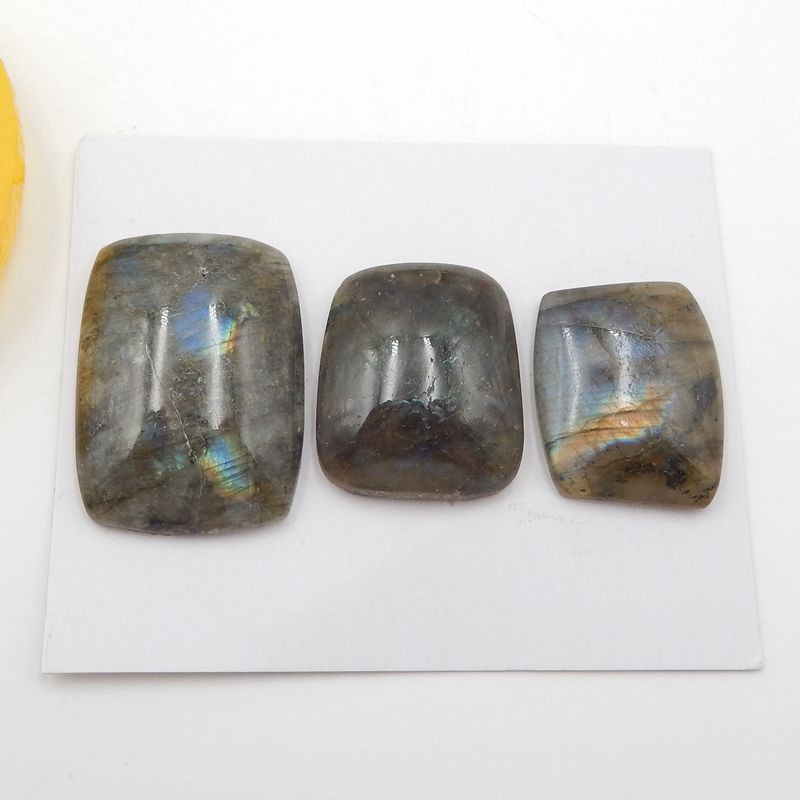
Labradorite
Labradorite is a semi-precious gem with a typically grey dark base, found in and named after Canada’s Newfoundland and Labrador province. However, it reflects iridescent colors, a quality that received its own name: labradorescence!
Unlike most gemstones, labradorite has an asymmetrical structure, likely stemming from its formation through lava crystallization. How about labradorite’s healing properties?
Labradorite is the matriarch of the subconscious, symbolizing wisdom, self-awareness, and protection. Labradorite healing properties include:
Protection against negativity
Decreased self-doubt
Soothing feelings of shame
Realizing lost memories
Leo, Scorpio, and Sagittarius can all call labradorite their zodiac stone!
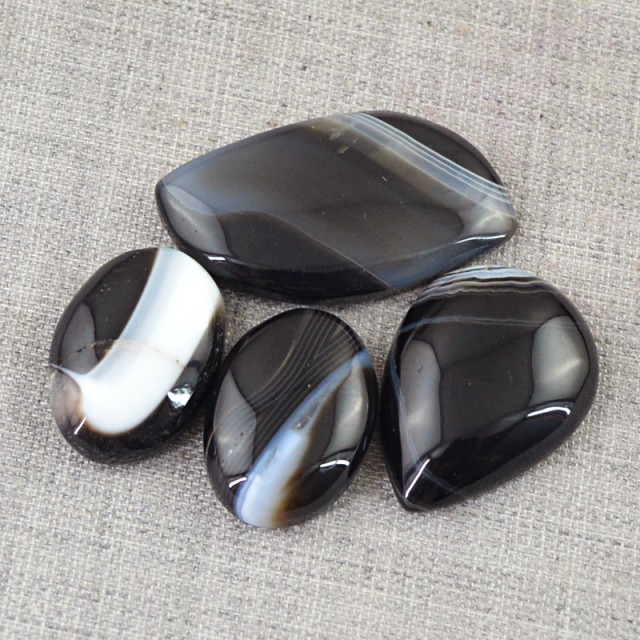
Onyx
This chalcedony stone has intense black shades and stripes. While usually black, many onyx stones are also grey, like the stones along the back of Onyx the Pokemon! The grey varieties of onyx are technically Niccolo Onyx, stones with black bases and translucent bluish-grey bands.
Onyx represents power and depth, though history painted onyx in quite a negative light. Ancient Chinese people believed onyx brought bad luck, while Victorians associated onyx with death, since Queen Victoria I wore onyx to her husband’s funeral.
In Greek mythology, onyx formed from a piece of Aphrodite’s fingernail after Eros, or Cupid, shaved it off with his arrow. This myth led to the stone’s name, as onyx means “claw” or “fingernail” in Latin.
As for healing properties — you’ll be blown away with the mental aspect of onyx’s powers. Nicknamed the “Stone of the Mind,” onyx represents mindfulness, restraint, and mental prowess. It’s thought to help with:
Memory loss
Stress
Concentration
Grief
Let’s move on to another stone with great mental healing properties!
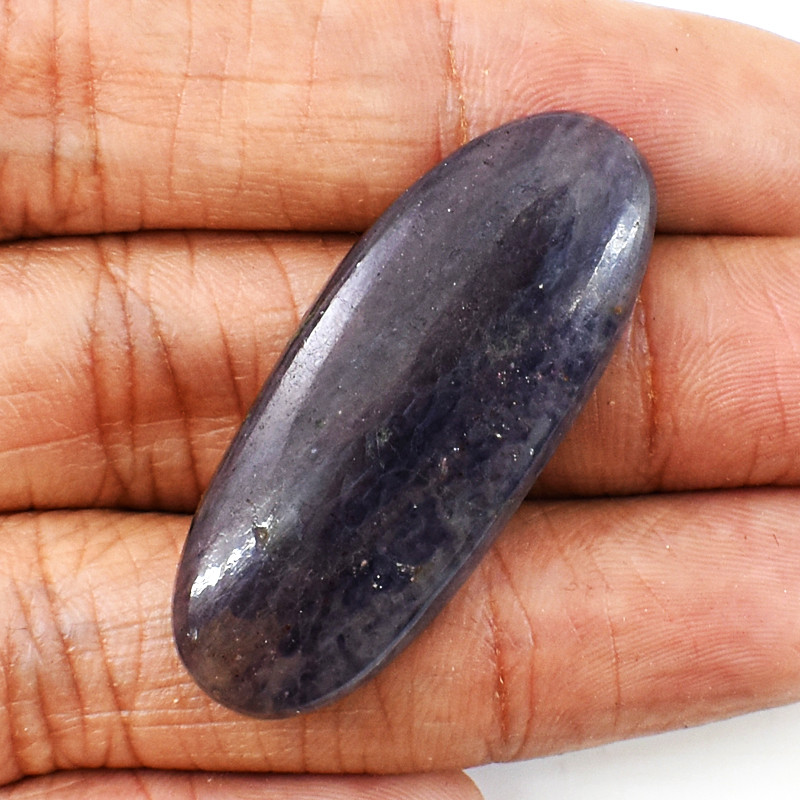
Iolite
Are you a traveler? A dreamer? This heavenly, violet-blue stone is the stone for you. Why is it on this list? Because it boasts gorgeous grey undertones in addition to its predominantly violet shades.
As Saturn's star stone, iolite is known for granting you better focus, encouraging you to step out of your comfort zone to bring you closer to your dreams!
Before being named iolite, this stone had the name dichroite, a Greek word for “two-colored stone.” This was because of its pleochroism, or its ability to shift colors from blue to yellow at different viewing angles!
Iolites resemble a well-known quartz variety: amethyst! What is grey amethyst then? Some say iolite, but they’d be mistaken. Iolite and amethyst are often mistaken because they are similar silicates, but iolite is cordierite, not quartz.
Iolite is nicknamed the “Viking’s Compass,” after the ancient travelers that traversed the seas with iolite’s pleochroism guiding them in the sun’s direction! With this context, it makes sense that iolite represents direction and intuition.
Speaking of intuition, iolite connects to our mindful third eye chakra. Its healing properties include:
Soothing migraines
Reducing insomnia
Clearing brain fog
Improving focus
Activating creativity
Ready for more? Let’s check out another gem that activates creativity!

Grey Calcite
Whether you know it or not, you’re probably surrounded by calcite, from furnishings to roads and even medicine! It comes in numerous different colors, more commonly orange and green. But calcite comes in grey crystals as well, earning it a spot on our list!
Despite calcite’s versatility in everyday features, it’s also a great stone for accessorizing. With a 3 ranking on the Mohs scale, though, calcite needs an extra layer of protection when used in jewelry.
Calcite comes from the Latin calx, meaning “lime.” That’s no coincidence, since calcite is the main ingredient of limestone, which we use for kitchen furnishings and more. It’s also an ingredient in marble for those oh-so-fancy countertops. But Ancient Egyptians used limestone as well, both in their homes and jewelry!
What does calcite mean? These transparent to translucent stones symbolize self-growth and awareness. Some of calcite’s healing properties include:
Boosted creativity
Enhancing self-trust and stability
Heightened energy
Strengthening bones
Reducing blood clotting
Ready for one more?

Chrysocolla
A copper silicate mineral, chrysocolla sports blue-green hues that promote tranquillity and inspiration. Sometimes chrysocolla has iron oxide inclusions, causing streaks of black and dark grey across the stone.
When you first see a chrysocolla gem, you might envision the egg of a gorgeous, tropical bird. That’s because its bluish-green hues are reminiscent of the Amazon, and its oval and sphere shapes remind us of eggs! True to form, chrysocolla is known to help with fertility.
Ancient Greeks called gold-soldering materials chrysocolla. This grey crystal’s name originates from the Greek chrysos (gold) and kolla (glue).
Though not an official birthstone, chrysocolla can be a more affordable alternative to turquoise, the December birthstone. Nicknamed the “Stone of Communication,” chrysocolla belonged to the ancient goddess Sophia, who represented wisdom.
Native Americans associated the stone with emotional resilience. These associations for chrysocolla continue to the present day, with modern healing properties like:
Soothing painful feelings
Clearing clouded judgment
Reducing anger
Regulating hormones
Reducing menstrual pain
Despite these strong healing properties, you’ll need to be gentle with this stone if you wear it as jewelry. It only has a 2-4 ranking on the Mohs scale, making it about as strong as a fingernail.
Channel Calmness and Tranquility with Grey Gemstones!
Grey gemstones redefine our common perceptions of the color grey. Channel your inner wisdom and ultra-cool vibes by wearing some grey gemstone jewelry today!
Search the Gemstone Encyclopedia
Related Auctions
Related Articles
Originally the Birthstones or gemstones were associated with a zodiac sign or the month of a individuals birth. Find out what your stone is and view the stones we have for sale
8th Feb 2021
There are so many tools on the market for testing a gemstone, but what are the main tools required for simple analysis. Lets look at four tools for gemstone testing.
4th Mar 2020
Gem Rock Auctions has one of the largest range of Certified Gemstones online. Browse this list of approved gemstone testing laboratories.
24th Jul 2018
Latest Articles
Yugawaralite is a rare colorless, white, or pinkish zeolite crystal named for its discovery in Yugawara, Japan. Here we uncover the multifaceted history, properties, prices, and uses of yugawaralite.
24th Mar 2025
Simpsonite is a lesser-known mineral known on the gem market for its durability, yellow-orange color, and rarity. Discover all the properties, uses, prices, and history of simpsonite.
3rd Mar 2025
Kurnakovite is a colorless crystal related to inderite and rarely faceted but known among collectors. Explore the mineral traits, history, prices, and more in this kurnakovite guide.
17th Feb 2025
Article Categories
How To's is where you will find helpful articles from gem Rock Auctions on how to cut gemstones, select gemstones and buy gemstones.
9 Articles








